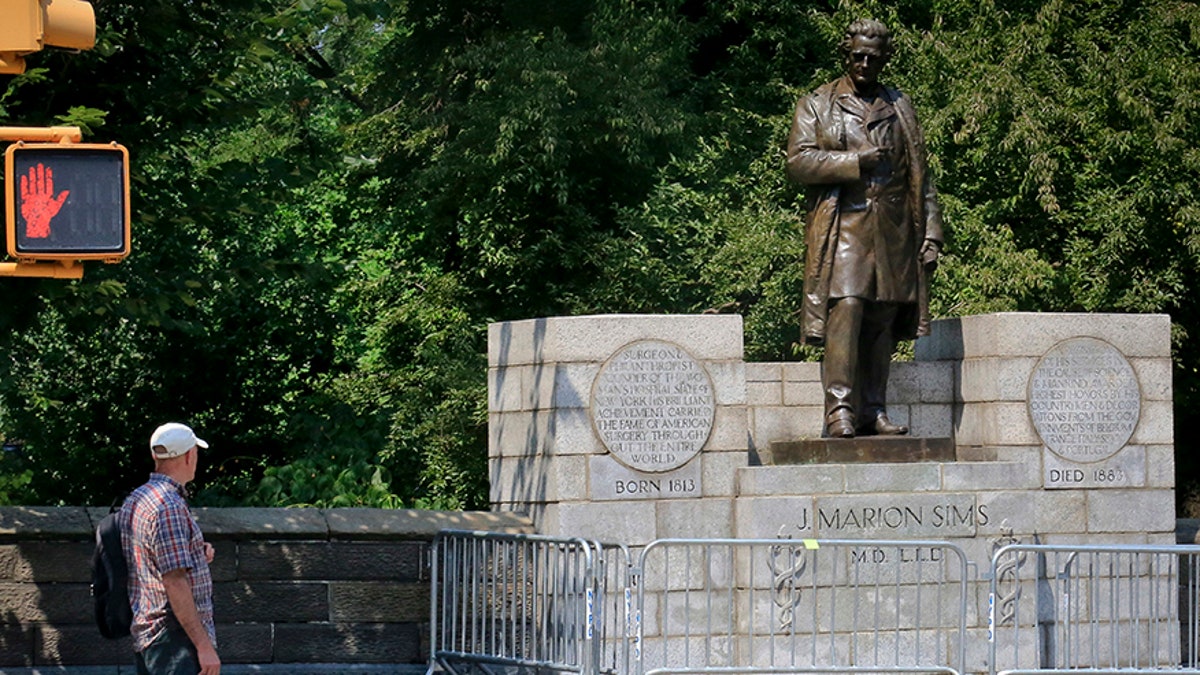
A man looks at the statue of Dr. J. Marion Sims in New York's Central Park. (AP)
A task force created to figure out what to do with controversial statues and monuments on New York City property – described by the mayor as “symbols of hate” – has recommended only one statue be moved from its current location.
Among the statues and monuments that came under scrutiny was the statue of Christopher Columbus that stands above Columbus Circle; a plaque in lower Manhattan for Henri Philippe Petain, considered a Nazi collaborator; and a Central Park statue of Dr. J. Marion Sims, who operated on slave women to develop advances in gynecological surgery.
"Thousands of New Yorkers got involved in this process, and there's been an important conversation going on across the city,” Mayor Bill de Blasio said Thursday in a statement. “Reckoning with our collective histories is a complicated undertaking with no easy solution. Our approach will focus on adding detail and nuance to — instead of removing entirely — the representations of these histories."
The Sims statue is the only one being moved, to the Brooklyn cemetery where he is buried. For the Columbus statue, the city wants to add historical markers and commission a new monument to honor indigenous people. Other markers would be added elsewhere to give additional context for other statues and monuments.
De Blasio launched the statue review last summer amid a national outcry over violence surrounding a white nationalist rally in Charlottesville, Va., over the removal of a Confederate statue. Attendees and counterdemonstrators brawled, and a counterdemonstrator was killed when a car plowed into a crowd of protesters.
At the time, de Blasio said a task force would be created to review "symbols of hate" on city property with an eye toward determining whether removals were necessary, the Associated Press reported.
But the decision not to move the Petain plaque didn't sit well with state Assemblyman Dov Hikind.
"It is immoral to publicly display the names of Nazis," he said. "We have a moral obligation to educate the public, and especially young people, by removing markers that commemorate individuals who willingly participated in the systematic murder of innocent men, women and children. Does anyone disagree with this? I don't think so. The excuse that it's too difficult is absurd and sends the wrong message."
Some city officials, including then-Council Speaker Melissa Mark-Viverito, had previously called for taking down the Sims statue and evaluating the Columbus one.
Vandals doused the Columbus statue's hands in blood-red paint and scrawled the words "hate will not be tolerated" in September, and three demonstrators briefly interrupted a wreath-laying ceremony at the monument during the city's massive Columbus Day Parade in October.
The scrutiny of Columbus riled Italian-American groups, and Gov. Andrew Cuomo said he favored keeping the sculpture. He said he saw it as honoring Italian heritage in New York, not overlooking the harm the explorer did to indigenous people.
De Blasio — an Italian-American Democrat like Cuomo — didn't opine on it.
"And we'll be taking a hard look at who has been left out and seeing where we can add new work to ensure our public spaces reflect the diversity and values of our great city," de Blasio added in his statement Thursday.
The 18-member commission included entertainer and civil rights activist Harry Belafonte, World Trade Center memorial designer Michael Arad, Spelman College President Mary Schmidt Campbell, and other academics, artists and writers.
At a public hearing in November, some speakers suggested certain monuments should go, while others called the committee's work an exercise in political correctness.
The Associated Press contributed to this report.

